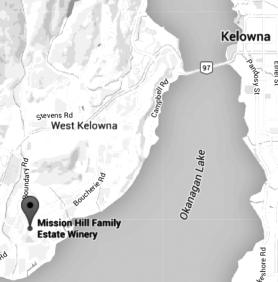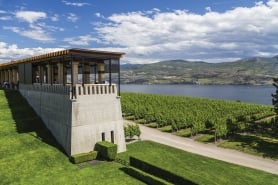Every wine region needs an icon winery — a winery that’s a magnet, that draws consumers to wine country. Ontario nearly had one such winery when Vincor hired world-renowned architect Frank Gehry to design a facility for Clos Jordanne. Gehry’s concept looked like a gigantic lemon meringue pie set in the middle of the vineyard on the Jordan bench of the Niagara Escarpment. Then, in 2012, Constellation – the world’s largest producer of wine, beer and spirits – bought Vincor. Bye-bye Gehry and his meringue pie.
Meanwhile, on the other side of the Rockies, British Columbia has had its go-to winery since 2001: Mission Hill in Westbank, near Kelowna. The proprietor is Anthony von Mandl who last November sold Mike’s Hard Lemonade and Okanagan Cider to Labatt Breweries for US$350 million.
I first met von Mandl in 1976 in the cellars of Roederer Champagne in Reims. He was, I believe, 22-years-old at the time. He was working as a wine importer for his uncle Josef Milz. We had lunch together and I said to my then wife, “This man is going to go far.”
Four years after we met, von Mandl purchased an ailing winery in Westbank, BC. He paid a reported $4 million for a facility once known as Uncle Ben’s Gourmet Wines. He closed the deal with owner Ben Ginter by a best-of-five coin toss at $25,000 a throw.
Financed with profits earned from his Mike’s Hard Lemonade business and the importation of Corona beer, von Mandl proceeded to recreate Mission Hill as the province’s most beautiful winery with a first-class restaurant overlooking Lake Okanagan. (A restaurant, incidentally, that was voted by Travel & Leisure magazine in 2009 as one of the five best winery restaurants in the world.)
Von Mandl could have bought vineyard land in Napa or in Europe. Instead, he demonstrated his confidence in the future of the British Columbia wine industry by investing $35 million in rebuilding his winery and purchasing new vineyards.
 The result is astonishing. The totally renovated property is one the most extraordinary wine facilities I have seen anywhere on my wine travels, complete with a collection of ancient glassware, a Leger carpet and a Chagall-inspired wall hanging.
The result is astonishing. The totally renovated property is one the most extraordinary wine facilities I have seen anywhere on my wine travels, complete with a collection of ancient glassware, a Leger carpet and a Chagall-inspired wall hanging.
The style of the original Mission Hill – with its 18th-century antiques, tiled floors and whitewashed walls, was reminiscent of the Mondavi model – as was von Mandl’s penchant for associating his enterprise with cultural events, including support for the Vancouver Symphony Orchestra.
Equally dramatic below ground as it is above, the refurbished Mission Hill boasts a magnificent crypt-like barrel-ageing cellar that extends in a gigantic L-shape under the winery. The visitor can peer down on the barrels through an “oculus” – a large lens-like glass set in a well at ground level that directs the only natural light into the cellar. Oculus is the name von Mandl chose for his flagship red wine — a Bordeaux blend of Cabernet Sauvignon, Merlot and Cabernet Franc.
In 1991 he hired a New Zealand winemaker, John Simes, who rewarded his boss three years later by winning the Avery trophy at the International Wine and Spirit Competition in London. The category was the “Best Chardonnay in the World” for Simes’s Grand Reserve Chardonnay 1992. In 2013 Simes brought home the Decanter World Wine Awards trophy for the “World’s Best Pinot Noir in the under £15 category.” And these were only two of the many international awards garnered by Mission Hill.
Von Mandl obviously has a penchant for antipodean winemakers, as Mission Hill’s current incumbent is Australian Darryl Brooker, formerly winemaker at Flat Rock Cellars and Hillebrand. Phil McGahan, another Australian, presides over the barrels at von Mandl’s most ambitious project to date, CheckMate Artisinal Winery, a tiny facility that specializes in the production of pricey, icon Chardonnays.
Each of the five wines produced at CheckMate have chess-reference names, and they come from three different Mission Hill vineyards: Capture Chardonnay (Osoyoos), Queen Taken Chardonnay (Golden Mile Bench), Little Pawn Chardonnay (Black Sage Bench), Attack Chardonnay (Black Sage Bench) and a blend of all three vineyards (Fool’s Mate Chardonnay).
I tasted these wines at a launch in New York City earlier this year, and they are without doubt the best series of Chardonnays I have tasted in Canada. (For my reviews see www.tonyaspler.com.) Never one to rest on his laurels, though, Anthony von Mandl has extended the family estates portfolio to include CedarCreek winery, Martin’s Lane (a winery named after his late father, currently under construction) and the above-mentioned CheckMate, which is housed in the old Domaine Combret facility in Oliver. And to improve the quality of Mission Hill’s Riesling, he invited Fritz Hasselbach of Weingut Gunderloch in the Rheinhessen, one of Germany’s leading winemakers to consult.
What von Mandl has wrought on a hilltop overlooking Lake Okanagan is an extraordinary achievement whose ramifications stretch well beyond the local wine industry. This is a destination for the world’s wine lovers.
If only Frank Gehry’s vision for an Ontario winery had become a reality as well.
Tony Aspler is the author of 17 books on wine, including his latest, Canadian Wineries.





